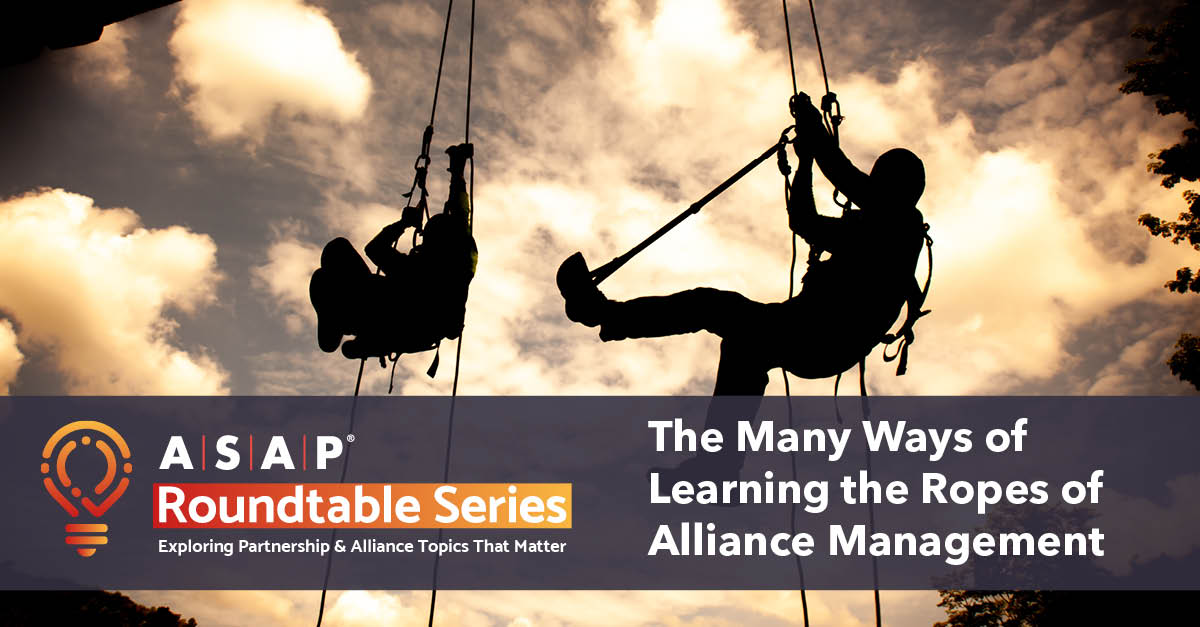The Many Ways of Learning the Ropes of Alliance Management
More than most white-collar disciplines, alliance management is learned largely on the job. While most business schools will cover marketing, sales, and business development basics, only a few offer any formal courses for those looking to learn how to optimize partnerships. Truth be told, not many people will have even heard of alliance management until they have arrived at a biopharma or IT company. Others might not know there’s a formal job for steering collaborations until they are asked to helm one themselves.
Either way, alliance management professionals need to get up to speed, and the latest ASAP roundtable, “Training, Coaching, Mentoring: Jump In and Sink or Swim Versus Train ’em Right,” accounted for the variety of ways people do so.
"They Pushed Me in the Pool"
Across four breakout groups, several “accidental alliance managers” shared how they were tasked with optimizing collaborations—and learning how to do so. One attendee participating in a discussion led by Louis Rinfret, PhD, founder and CEO of allianceboard, shared that her company “pushed me in the pool and said, ‘good luck’” in a new role which she didn’t even know “had a name.” That individual was able to tap a previous alliance manager for some help learning the ropes.
Not everybody is lucky enough to have a predecessor at all. In a conversation being moderated by Jarrod Midboe, CCRC, PMP, BS, director of clinical affairs and vendor and alliance management at Upsher-Smith Laboratories, one former strategic account rep told of how he was charged with building an alliance practice from scratch with no previous experience. He leveraged ASAP articles, white papers, tools, and processes, as well as 10-15-minute videos from another organization. He is now using those videos to train a new employee.
“We watch one video, discuss the content, answer questions she might have, and apply learnings before going on to the next one,” he said as he laid out his training process. He added that this exercise results in a “day-to-day understanding of the job.”
Another member of Rinfret’s subgroup similarly observed that it helps if organizations have alliance management onboarding processes that indoctrinate the culture and mindset of collaboration, particularly in smaller organizations that are more likely to lack the institutional alliance knowledge that is more common in larger organizations.
That doesn’t mean larger organizations don’t rely on a video-based curriculum. One attendee spoke of a collection of recordings his company made detailing a number of real-life case studies illustrating different facets of alliance management, such as contract negotiations, conflict resolution, and financial figure resolution.
Give Us the Tools—and a Few Good Models
Those who didn’t have the benefit of a formal program have leaned largely on ASAP tools and training. In the breakout group led by Kristin Rosner, PhD, CA-AM, director of alliance management in the GI drug discovery unit at Takeda, and Amy Hansen, CA-AM, senior alliance manager at Nutanix, the majority of participants gave a “huge plug” for The ASAP Handbook of Alliance Management, as most in the discussion came to alliance management “organically” and were “self-taught,” said Rosner in her post-roundtable summary. The aforementioned participant in Rinfret’s conversation disclosed that she is an avid reader of ASAP’s flagship publications Strategic Alliance Quarterly and Strategic Alliance Monthly.
Either way, it’s optimal to provide a blend of curriculum-based and hands-on learning. As Norma Watenpaugh, CSAP, founding principal at Phoenix Consulting Group, expounded toward the end of the program, you can only get so much from the Handbook. Some skills have to be inculcated through coaching and “on-the-job modeling,” particularly in companies that don’t invest sufficiently in professional development and “career pathing.”
Where's the Copier? Reverse Mentoring Gets Real
It might be reassuring to know that some have in fact learned at the knee of veteran alliance management professionals, such as the ex–Xerox employee who credited former ASAP board chairman Russ Buchanan for providing thorough guidance and hands-on teaching in a career that now sees her building alliance practices for smaller companies in a consulting role. Another former Big Pharma head of alliance management arrived at his leadership post without experience, forcing him to “reverse mentor” and learn from the existing alliance team. His organization would go on to establish a monthly get-together with a cross-functional group of alliance stakeholders to share best practices, solicit tips for overcoming challenges, and present case studies.
Inherent or Inherited?
As Watenpaugh’s breakout group’s conversation unfolded, a debate about “nature versus nurture” broke out. Yes, mentoring is vital, but some things cannot be taught. Or as Watenpaugh explained in her recap, some of these skills and attributes, such as relationship-building, are equally or more often “born” rather than acquired through “formal training.”
Another interlocutor from Rinfret’s group came to a similar conclusion.
“There’s trainings you could take—like the ASAP frameworks—but at the end of the day there are certain skills people have to possess to be good at this role,” she said, before citing communication, organization, soft skills, and problem-solving as examples. Although a good boss, a strong organizational structure, and other support systems help in picking up the fine points of the profession, some of it is “inherent in the person.”

